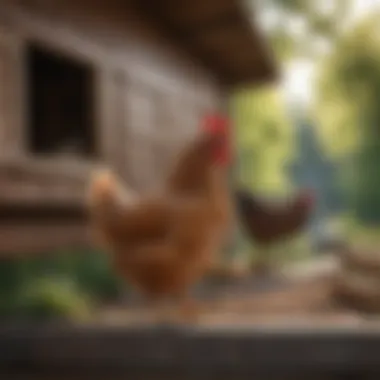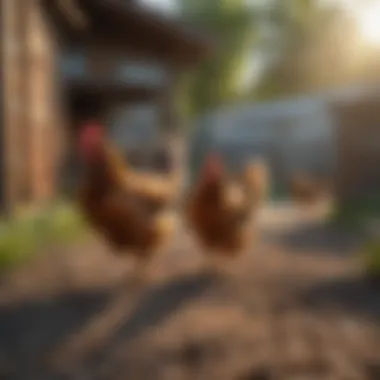Constructing a Functional Chicken Coop: A Complete Guide


Intro
Constructing a chicken coop requires careful planning and consideration. Chickens need a safe and comfortable environment to thrive. The design of your chicken coop can impact the health and productivity of your flock. Various factors, such as location, climate, and the number of chickens, will influence your choices.
This guide serves as a resource for both novice and experienced chicken keepers. It dives into essential aspects of creating a functional chicken coop, from selecting appropriate materials to understanding necessary features. The aim is to provide a comprehensive understanding of chicken housing needs that will ensure your chickens live in a secure and healthy environment.
Design Considerations
Designing a chicken coop involves multiple factors. You must assess the space available in your yard. Chickens need adequate room to move around, both indoors and outdoors. As a general rule, each chicken requires approximately 4 square feet of space inside the coop and 10 square feet in an outdoor run. Environmental factors, such as rainfall and temperature, should also dictate the design.
Important Features to Include
- Ventilation: Proper airflow prevents respiratory problems in chickens. Consider installing windows or vents.
- Lighting: Natural light is important for overall health. Ensure the coop allows sunlight in.
- Accessibility: Incorporate access points for feeding, cleaning, and collecting eggs.
Materials Selection
Choosing the right materials is crucial for durability and safety. Common materials include wood, wire mesh, and corrugated metal. Pressure-treated wood can withstand moisture and pests. Wire mesh is essential for keeping predators out while allowing airflow. Whatever materials you select, they must be sturdy enough to withstand the elements and protect your flock.
Recommended Materials
- Flooring: Use wood or concrete to provide a solid base.
- Walls: Choose weather-resistant materials, like plywood or metal.
- Roofing: Ensure a water-resistant roof with a slope to facilitate drainage.
Essential Features for Health and Safety
The health and safety of your chickens depend on the features implemented in the coop. Certain items are essential for conservation and protection.
Must-Have Features
- Nesting Boxes: Provide a comfortable space for egg-laying.
- Roosting Bars: Chickens prefer to sleep off the ground. Consider installing these at varying heights.
- Safety Measures: Ensure doors and windows have locks to prevent predators.
The End
Understanding the Purpose of a Chicken Coop
Creating a chicken coop is not just a fun project. It is about establishing a safe environment for your chickens. Understanding the purpose of a chicken coop is crucial for success in chicken keeping.
Why a Chicken Coop is Essential
A chicken coop serves multiple purposes. First, it protects your chickens from predators, such as raccoons or foxes. These animals can easily breach common backyard barriers. A solid structure keeps your birds safe, allowing them to roam freely during the day while resting securely at night.
Second, a coop provides shelter against harsh weather. Chickens need protection from rain, heat, and cold. A well-built coop offers shade, insulation, and comfort, ensuring your chickens remain healthy regardless of external conditions.
Finally, the coop acts as a controlled environment for growth and egg production. Chickens require a space that is clean and free from diseases. Having a dedicated area allows for easier management of hygiene and overall health.
Key Benefits of Proper Housing
Proper housing provides various advantages that lead to better chicken welfare.
- Healthier Chickens: Adequate space, ventilation, and cleanliness reduce the risk of disease. Chickens in cramped or dirty conditions are more susceptible to illnesses.
- Increased Egg Production: A comfortable, stress-free environment encourages hens to lay more eggs. Stress can easily affect their laying patterns, so a well-designed coop benefits egg production.
- Enhanced Behavior: Chickens are social animals. A proper coop design enables them to engage naturally with each other, reducing aggressive behavior and improving overall wellbeing.
Proper housing is vital not only for the chickens’ protection but also for their productivity and health.


In sum, understanding why a chicken coop is essential and recognizing the benefits of proper housing sets the foundation for creating an effective space that supports your flock’s needs.
Fundamentals of Chicken Coop Design
Understanding the fundamentals of chicken coop design is crucial for anyone looking to keep chickens responsibly. A poorly designed coop can lead to various issues such as health problems for the birds, ineffective use of space, and increased risk of predator attacks. Proper design focuses on creating a safe and comfortable living environment while also accommodating the specific needs of your flock. It combines functionality with enable efficient management of space, ensuring that chickens can thrive.
Size and Space Requirements
Size is one of the primary considerations when designing a chicken coop. Chickens require adequate space to move freely, exercise, and establish a social hierarchy. The general guideline is to provide a minimum of 4 square feet per bird inside the coop and 10 square feet in the outdoor run. This prevents overcrowding, which can lead to stress and aggressive behavior among the flock.
In urban settings, size restrictions may apply, so checking local regulations is essential. Ensure that the coop fits comfortably in your yard while following zoning laws. Additionally, plan for future expansion if you intend to grow your flock over time.
Ventilation and Airflow Needs
Ventilation is another key aspect of coop design. Proper airflow helps regulate the indoor environment, reducing humidity and ammonia buildup, which can harm chickens’ respiratory systems.
Well-placed vents can encourage cross-ventilation. Roof vents, windows, and adjustable openings can all contribute to optimal airflow. When designing your coop, consider the prevailing winds in your area and the orientation of ventilation openings. This can enhance airflow without causing drafts that might be harmful to the birds, especially in winter months.
Layout Considerations
The layout of your chicken coop is equally important. A functional design should consider factors such as the placement of nesting boxes, food dispensers, and water supplies. Nesting boxes should be accessible yet private, encouraging hens to lay eggs in a safe environment. Generally, one box for every three to four hens suffices.
Additionally, arrange food and water stations to prevent overcrowding during feeding times. Adequate walking space should be provided to ensure the chickens can move, interact, and engage in natural behaviors. Access points for cleaning are important as well; they should be conveniently placed to facilitate maintenance without stressing the birds.
Important Note: A well-thought-out design enhances the overall wellbeing of your birds, making maintenance easier and reducing health risks.
Materials for Building a Coop
Choosing the proper materials is crucial in constructing a chicken coop. Quality materials not only ensure the structural integrity of the coop but also contribute to the health and safety of your chickens. It is essential to invest time in selecting the right options to create a suitable environment for your birds. Factors like durability, insulation, and predator resistance are paramount considerations in this process.
Choosing the Right Lumber
When building a chicken coop, selecting the correct type of lumber is vital. Softwoods like pine and fir are commonly used due to their availability and affordability. However, these types can be less durable than hardwoods. While hardwoods such as oak may be more expensive, they offer enhanced strength and longevity. It’s advantageous to consider not just the cost but also the long-term implications of your choices.
Moreover, ensure the lumber is untreated to avoid exposing the chickens to harmful chemicals. The dimensional stability of the wood is another factor; it should be stable enough to last through changing weather conditions. You might also consider reclaimed wood as an eco-friendly option, but it must be inspected for pests or rot prior to use.
Insulation and Weatherproofing
Insulation is an essential element that ensures your chickens remain comfortable in varying temperatures. In colder regions, using insulation materials like foam boards or fiberglass insulation can help retain heat. This is critical during the winter months. On the other hand, in hotter environments, proper insulation can assist in keeping the interior cool.
Weatherproofing is equally important. Ensure that the roofing material and siding are made from water-resistant materials. Metal roofs are a good option here, as they shed rain and snow. Additionally, applying sealant or weather-stripping around doors and windows helps to keep the coop dry. Be cautious of the materials you use, as they can impact the coop's temperature and health of your chickens.
Predator-Proofing Materials
Predator-proofing is a necessity in coop construction as it protects your flock from potential dangers. Using strong materials like hardware cloth instead of chicken wire can significantly enhance security. Hardware cloth is more rigid and less easily breached by animals. Also, consider using solid timber or metal for the coop's frame to withstand attempts from predators.
You should also think about the flooring. A solid floor can deter burrowing animals from accessing the coop. Some poultry owners opt for concrete floors for maximum durability, while others might prefer wooden ones as long as protective measures are in place. Don’t neglect the importance of high-quality locks on access points to ensure that your chickens are safe from intruders.
Quality materials will not only enhance the longevity of your chicken coop but also improve the overall well-being of your chickens.
In summary, careful selection of materials is foundational in constructing a chicken coop. Paying attention to lumber choice, insulation and weatherproofing, and predator-proofing can prevent future issues and promote a safe environment for your chickens.
Essential Features of a Chicken Coop


Building a chicken coop is not just about sheltering your flock; it involves creating a space that enhances their health and productivity. Essential features play a critical role in achieving this goal. Understanding the components of a functional coop ensures that your chickens can thrive, stay safe, and remain comfortable, thus aligning with their natural behaviors.
Roosting Bars and Nesting Boxes
Roosting bars are among the core features of a chicken coop. Chickens naturally seek elevated places to sleep, which is where roosting bars come into play. These bars need to be sturdy and spaced appropriately to accommodate all chickens in the coop. It's important that they are higher than the nesting boxes since chickens prefer roosting above. Typically, a diameter of about 2 to 4 inches is ideal, providing comfort while preventing feet injuries.
Nesting boxes are equally vital, providing safe and private places for hens to lay eggs. Each box should measure about 12 inches square. Adding soft bedding such as straw or pine shavings can further encourage usage. Having at least one nesting box for every three hens is widely recommended to avoid competition and stress. A well-structured approach to roosting and nesting can lead to healthier chickens and, consequently, a more productive flock.
Access Points for Cleaning
Cleaning the coop is crucial for maintaining the health of your chickens. Effective access points allow for easy sanitation practices, limiting the buildup of waste and potential pests. This can be achieved through various designs. A large door at the rear or side simplifies cleanout tasks, while smaller access doors can facilitate daily inspections and minor cleanings.
Materials used for flooring can influence cleaning efficiency. For example, concrete or treated wood can simplify scrubbing and are more resistant to moisture. It is also advisable to incorporate removable trays or screens beneath the roosting bars. This allows concentrated droppings to be easily collected. A cooperative cleaning plan benefits both the coop’s hygiene and the overall well-being of the birds.
Water and Food Requirements
Chickens need a steady access to clean water and a proper feeding system for optimal health. Their water supply should be fresh and changed daily. Using a hanging waterer can help keep the water clean and reduce spillage. Additionally, the design of feed stations matters. It is best to have elevated feed containers that prevent waste from contamination.
Providing a balanced diet is also essential. For laying hens, a layer feed enriched with the right nutrients fosters egg production. Grit is important as well, aiding in digestion by grinding food in their gizzards. Ensuring that simple yet effective feeding and watering systems are in place maximizes the comfort and productivity of your flock.
In summary, the essential features of a chicken coop—roosting bars, nesting boxes, cleaning access points, and water and food systems—are paramount. They contribute not only to the structure but also to the overall welfare of the chickens.
Building Process Overview
Building a chicken coop is not just a construction project; it is a vital process that ensures the wellbeing of the chickens you intend to keep. Understanding the building process is essential for several reasons. First, it allows you to create a structure that meets the specific needs of your chickens, ensuring their comfort and safety. Second, a carefully planned construction process minimizes errors and reduces the overall costs associated with the project. Finally, knowing how to build correctly helps maintain the longevity of the coop.
Step-by-Step Construction Guide
Constructing a chicken coop involves a series of steps that, if followed diligently, can lead to a functional and safe environment for your birds. Here is a brief overview of these steps:
- Planning: Start by outlining your design. Consider the number of chickens, their living space, and your available budget. Make sketches to visualize the layout and ensure it meets the chickens' needs.
- Selecting a Site: Choose a location that provides adequate sunlight, drainage, and protection from wind. The site should be easily accessible for cleaning and maintenance.
- Gathering Materials: Acquire all necessary materials including lumber, nails, roofing, and fencing. Quality materials will increase the lifespan of the coop and protect your chickens from predators.
- Building the Framework: Begin with the floor and gradually construct walls and roof, ensuring that the structure is level and stable. Pay attention to the insulation and ventilation requirements.
- Installing Essential Features: Once the main structure is up, focus on adding roosting bars, nesting boxes, and access points for feeding and cleaning.
- Finishing Touches: Apply any necessary paint or sealant to protect the coop from moisture and pests. Check that every opening is secure to prevent intruders.
This step-by-step guide ensures that your coop construction is systematic and efficient. Every step contributes to the overall function and safety of the coop, thus creating an ideal environment for your chickens.
Tools and Equipment Needed
A successful build requires the right tools and equipment. Here is a list of essential items:
- Measuring Tape: To ensure accurate dimensions.
- Circular Saw: For cutting lumber to size.
- Hammer and Nails: Essential for joining materials together.
- Screwdriver and Screws: Useful for assembling parts of the coop.
- Drill: Important for making holes and securing screws.
- Level: Ensures that the structure is even during construction.
- Pliers: Handy for gripping and twisting.
- Safety Gear: Includes gloves, goggles, and a dust mask.
By having the right tools at hand, the construction process becomes smoother and more efficient. Each tool plays a specific role in ensuring that the coop is built with precision and care.
Building a chicken coop is a significant investment in the wellbeing of your birds. Taking the time to plan and execute each step carefully will yield a structure that serves its purpose effectively.
Maintaining a Chicken Coop
Maintaining a chicken coop is critical for the wellbeing of the chickens. Proper maintenance not only ensures the animals are safe but also enhances their productivity. Neglecting the coop can lead to increased health risks for the chickens, potentially resulting in disease outbreaks that can decimate a flock. Moreover, a clean and well-kept coop can minimize bad odors and pests, making the experience more pleasant for the owner.
Routine Cleaning and Maintenance
Routine cleaning is a daily and weekly responsibility for anyone who keeps chickens. Regularly removing waste is essential. Chicken droppings can contain pathogens, which can affect both the chickens and potentially the humans tending them. It's advisable to clean the coop at least once a week to prevent any buildup.
Here are the main tasks involved in routine cleaning:


- Remove bedding: Take out old bedding and replace it with fresh straw or wood shavings to maintain a clean environment.
- Scrub surfaces: Cleaning the coop's walls and floors on a monthly basis helps to eliminate bacteria and build up of dirt.
- Check the water and food containers: Ensure that water is fresh and that the food is not spoiled. Clean these containers regularly to avoid contamination.
- Inspect tools and equipment: Regularly check for wear and tear on feeding and watering systems to avoid failures.
By following these steps, chicken keepers create a safe environment that promotes the chickens’ health.
Monitoring for Pests and Diseases
Monitoring for pests and diseases is equally important to maintain the health of the flock. Pests such as mites and lice can cause significant discomfort for chickens, while diseases can spread quickly and affect the entire flock. Regular inspection can help catch these issues early.
Consider the following practices when monitoring your chickens:
- Watch for signs of illness: This includes changes in behavior, reduced egg production, or changes in their appearance like feather loss.
- Inspect regularly: Examine the inside and outside of the coop for signs of pests. Look for droppings or skin and feather debris that might indicate a pest issue.
- Implement preventative measures: Consider the use of natural deterrents, such as diatomaceous earth, to control pests before they become an issue.
- Consult a veterinarian: If you notice any signs of illness or pest infestation, it’s best to seek professional advice promptly.
Maintaining a chicken coop is a duty that requires diligence and care. By prioritizing routine cleaning and active monitoring for pests and diseases, chicken keepers can help ensure a healthier and more productive flock.
Common Challenges in Coop Construction
Constructing a chicken coop is not without its challenges. Understanding these challenges is crucial for anyone looking to provide a safe and efficient home for their flock. The design and construction process can be affected by various factors, from legal restrictions to environmental conditions. Addressing these issues upfront can save time, resources, and potential frustrations in the future.
Dealing with Local Regulations
Before starting the construction of a chicken coop, it is important to research local regulations regarding poultry keeping. Many municipalities have specific rules regarding the size of the coop, distance from property lines, and the number of chickens allowed. Ignoring these regulations can lead to fines or the need to demolish or relocate the coop.
Here are some aspects to keep in mind:
- Zoning Laws: Check if your location is zoned for residential poultry keeping.
- Coop Size: Many areas specify minimum and maximum size requirements for the coop.
- Noise and Odor Regulations: Consider how your chickens may affect neighbors and whether noise or odor limitations exist.
A good strategy is to contact local agencies or neighbors with poultry experience. This step will help ensure compliance with relevant laws, allowing for a smoother construction process.
Environmental Considerations
Environmental factors play a significant role in the health and well-being of chickens, which in turn affects the construction of a chicken coop. Proper attention to environmental considerations can enhance the longevity and functionality of the coop.
Key points to address include:
- Climate Conditions: Assess the local climate. In hotter areas, it is vital to ensure proper ventilation. In colder climates, insulation comes into focus.
- Ground Conditions: The site where the coop is built should be well-drained. Muddy ground can lead to hygiene issues and health problems for the chickens.
- Waste Management: Consider how waste will be managed and composted to minimize environmental impact and attract fewer pests.
Taking a proactive approach to these environmental aspects will create a more suitable habitat for chickens. This effort may also contribute to a sustainable living environment for the owner.
Remember: Addressing these challenges at the start can prevent complications later, creating a positive experience for both the chicken keeper and the flock.
Culmination
The conclusion of constructing a chicken coop serves as a vital wrap-up of the key elements discussed throughout this guide. Not only does it synthesize the information presented, but it also underscores the importance of building a functional and safe environment for chickens. A well-constructed chicken coop ensures the welfare of the birds, facilitates their natural behaviors, and ultimately contributes to their health and productivity.
Summary of Key Points
- Purpose of a Chicken Coop: The coop serves as a protective space, safeguarding chickens from potential predators and harsh weather.
- Design Fundamentals: Considerations in size, ventilation, and layout are essential for a comfortable living space.
- Materials Selection: Choosing appropriate materials affects the coop's durability and insulation.
- Essential Features: Roosting bars, nesting boxes, and proper access points are critical for the chickens’ well-being.
- Maintaining the Coop: Regular cleaning and pest monitoring are crucial to prevent diseases.
- Common Challenges: Awareness of local regulations and environmental factors helps in planning.
This summary emphasizes the complexity and importance of creating a supportive habitat for chickens, aiding both novice and experienced chicken keepers.
Final Considerations
As one embarks on the journey of constructing a chicken coop, it is necessary to approach this project with careful planning and consideration. Every decision, from design to materials and maintenance, plays a significant role in the overall success of the coop.
Reflect on the specific needs of the chicken breed you choose, as different breeds may require varied spaces and environments.
The investment of time, resources, and careful thought will not only safeguard your chickens but also enhance their quality of life. By following the outlined steps and paying heed to the challenges that might arise, one creates a robust and healthy environment that fosters growth and productivity.
Remember: A happy chicken is a healthy chicken. Ensuring they have the right space and care is paramount to an enriching experience in poultry keeping.







